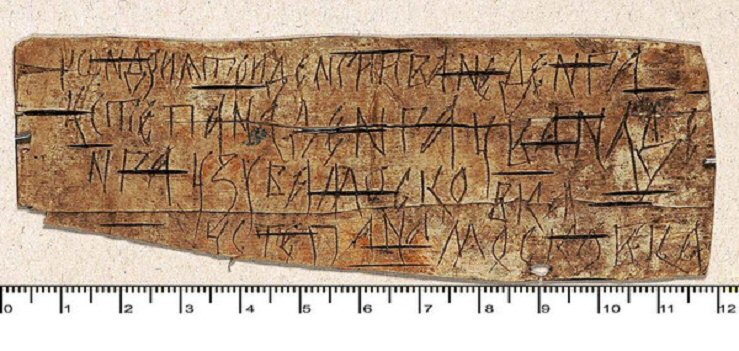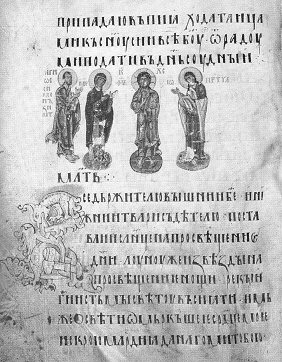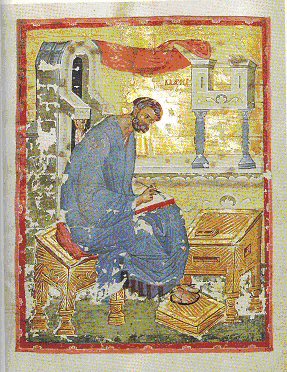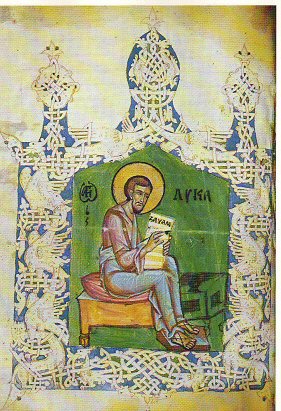

Springtime greetings to you! This issue, we have a short piece about leather that I lifted (with permission) from Sfandra's post to the List and also Sofya's article about Russian Calligraphy that I was unable to publish last time. We also have Sofya's account of the SIG Gulf Wars gathering.
Speaking of gatherings, Mordak has agreed to be the MC at this year's Pennsic gathering (“It'll be late afternoon so bring books, projects, any food or booze you want”), but we don't have the time or place worked out yet. Hopefully, we'll be able to publish the details in the summer issue.
Meanwhile, there have been discussions about another Slavic University, hopefully in Fall 2011. The current plan is to host it in Calontir, but I remain interested in seeing if we can get a host in one of the more western kingdoms.
By Sofya la Rus
We had a lovely gathering of Easterners in the lecture tent on Artisan's Row on Friday afternoon at Gulf Wars this year. It was a small group of eight or nine people, but the comradeship and conversation were great. We passed around books and medieval Slavic coins, and shared information, favorite sources, pickled mushrooms and sugared almonds. As the Lithuanian in attendance noted, it was nice to be with people who didn't look like “deer in headlights” when asked about Eastern Europe. I look forward to many more SIG Gatherings at Gulf Wars in the future.
By Sfandra Dmitrieva Chernigova
[Editor's note: This originally appeared as a response to a discussion about making boots on the SIG List, but I thought it makes an interesting stand alone article]
You actually will want several different thicknesses. For the uppers (over the foot, up the calf), it'll depend on how stiff you want the boot to stand. My lord Aleksei's boots are 8 oz leather. When on, they stay up well, with minimal slouching, though when off they flop over.
For the SOLE, you'll want Sole Leather. There's a slightly different tanning process for sole leather, which leaves it tough enough for the beating it will get. 12 oz sole leather is probably tough enough for SCA purposes -- you won't be wearing them every day. However, if you're going to build up a heel, you don't want to go much higher than 1” (even only 3/4 inch I'd say) because then you're getting to the point where you'll need extra arch support from heel to toes, and that's usually accomplished these days with a metal shank.
Last but not least is the lining. At the very least, you'll want a softer footbed, so you want very fine soft leather, maybe even pigskin. You might want enough to line the whole boot.
For footwear in general, you're going to have to make a tough call: veggie-tan versus chrome tan. I doubt you'll find brain-tanned anywhere these days, short of developing a relationship with a hunter. Chrome Tan is cheapest, but not period, holds up to wet weather better, and is sometimes dyed during processing, which makes it hold its color better. It cannot be tooled. Veggie-tan is the type used for leather carving & shaping (such as leather armor), is unstable when wet (will stretch then shrink and possibly crack), when wet and very warm it shrinks severely and becomes brittle (look up boiled leather armor or Cariodoc's Perfect Armor). It usually comes undyed, takes color very well (be warned, it soaks it up like water, and might shrink because of that - this has happened to my coronet), and can be tooled. It can also be SEALED with specific products (Feibing's Leather Sheen), and should be resealed regularly. I've used upholstery thread on leather projects and coated it with Leather Sheen and have not seen any problems with thread discoloration or anything.
I personally have found that for my little random projects, I like chrome tanned, but if I were shaping or tooling, or doing an A&S project, I'd probably do veggie-tanned.
Lining the boot & shaft will help with the boot standing up, but you could always get your hands on a pair of plastic boot shapers ( http://www.containerstore.com/shop?productId=10000125&N=&Ntt=boot ) for display purposes.
It is impossible to convey a thousand years of Russian manuscript art in one or two short articles. Here in part one, I will present a few examples of calligraphy and illumination to give a taste of the range of Russian manuscript forms. In part two, I will provide details about how I recreate a classic medieval Russian hand.
Electronic versions of many medieval Russian manuscripts are becoming available on the internet. Most surviving illuminated manuscripts are of a religious nature, but many secular documents survive, although they are usually fairly plain.
The famous birchbark letters are found in archeological deposits in northern Rus, where unique cool, damp clay soil conditions allowed their preservation. They provide evidence of widespread literacy in Rus even among the “lower” classes. The texts are everyday correspondence that was read and then discarded.
They were written using a hard pointed stylus to scratch or indent the letter forms into the surface of the bark without any need for ink. This technique dictated that the letters be fairly simple and almost runic, but one can see serifs and evolution in writing styles over time.

1100-1120 Novgorod

1450-1500 Novgorod
The documents have been folding into narrow lengths. Lead or wax seals were attached with cording.

11th century grant with a blocky, formal uncial hand. (Uncial means that the letters are almost all the same height.)

14th century document written with a relatively informal semi-uncial hand. (Semi-uncial means that a lot of letters are extra-tall or extra-long to extend beyond the main body of the letters.) Note the narrow strip of parchment along the bottom folded back to support the seal.

1372 award grant. One of the very few with illuminations, it has a very formal uncial hand reminiscent of the great Russian psalters (see below). The illustration is based on the Deesis - Christ flanked by Mary and John the Baptist and other appropriate saints.

1552 Ivan Charter. Note the dramatically different hand with lots of fancy flourishes.
The Russian chronicles and histories were usually collected and written by clerics with a strong moralizing tone. They were more carefully written that either the birchbark letters or the legal documents, and were often illustrated.

Russian Primary Chronicle - 1250-1300 Codex, a clean and simple uncial hand.

Radzivill Chronicle - 15th Century, an illustrated copy of a 13th century manuscript. Hand is slightly italic and more flowing compared to the 13th century codex above. Illuminations are fairly crude and child-like.

Life of Alexander Nevskij, 16th century. A similar hand to the 15th century Radzivill Chronicle, but with a very different style of illustrations.
The Psalters in Russia had a similar function as tools for personal worship as Books of Hours did in the West. Many psalters and similar texts were commissioned by wealthy patrons, whether secular nobility or leading church figures. Therefore, they were the most carefully written and the most richly decorated, with influences from icons and gold enamel work. And they were also the most likely to be carefully preserved.


Izbornik Sviatoslava - 1073, a compilation of various bits of information with detailed illuminations, clear uncial script. I'm particularly impressed by the little birds.

Mstislav Lectionary - 12th century. Novgorod image of St. Luke. Lots of gold leaf, more intricate borders.

Kiev Psalter - 14th Century. More informal, yet dainty and elegant style of illumination and a crisp, beautiful clear hand.

Simon Psalter - 13th century. An image of St. Simon joins the standard Deesis triptych of Mary, Jesus and John the Baptist. Note the clear uncial hand and intricate knotwork initial.

Khritrovo Lectionary - late 14th/early 15th centuries. Moscow, St. Mark. Illumination is reminescent of the style of Andrei Rublev with a more pastel palette.

1499 Bible. A late period example of the common style of putting a block of illumination at the top of the manuscript page, with a line of decorative text below it. The hand of the main block of text here is more “cursive” than the previous examples.

15th Century Lectionary, Pskov - St. Luke. Intricate knotwork borders seem to be popular in this period and a more pastel palette is appearing.

Theodosius Gospel - 1507, Moscow. Calligraphy follows the fluid, semi-uncial style we've already seen in the chronicles of this period. The extremely intricate illumination is unique and reminiscent of Muslim art.
• Birchbark letters - http://gramoty.ru/
• Drogin, Marc. Medieval Calligraphy: Its History and Technique. Dover, New York, 1980.
• Kolchin, B.A. and T.I. Makarova. Drevnaia rus, byt i kultura. Science, Moscow, 1997.
• Moscow Museum of Art and Industry. Medieval Russian Ornament in Full Color From Illuminated Manuscripts. Dover, New York, 1994.
• Past of Russia in Pics - lots of period manuscripts http://oldrussianscript.mylivepage.ru/ (Seems to be password protected now)
• Popova, Olga. Russian Illuminated Manuscripts. Thames and Hudson, New York, 1984.
• Shepherd, Margaret. Calligraphy Alphabets Made Easy. General Publishing Co. Ltd, Toronto, 1986.
• http://sofyalarus.info - my other stuff
Standard Disclaimer Stuff: Most of us are members of the Society for Creative Anachronism, Inc (SCA) but our Interest Group and its newsletter are not officially affiliated with the SCA. Naturally, then, Slovo does not bear any intentional resemblance to anything that the SCA officially endorses.
The original authors retain the rights to their works. Please contact them directly for permission to reprint. Uncredited material is the property of the publisher.
The publisher and editor is Paul Wickenden of Thanet (Paul Goldschmidt), 5625 Highland Way, Middleton WI 53562, 608-827-6891, e-mail: goldschp@tds.net. There is no subscription fee and copies of this quarterly newsletter are available free of charge from the editor. Slovo is also available on-line at the Interest Group web site (http://slavic.freeservers.com).